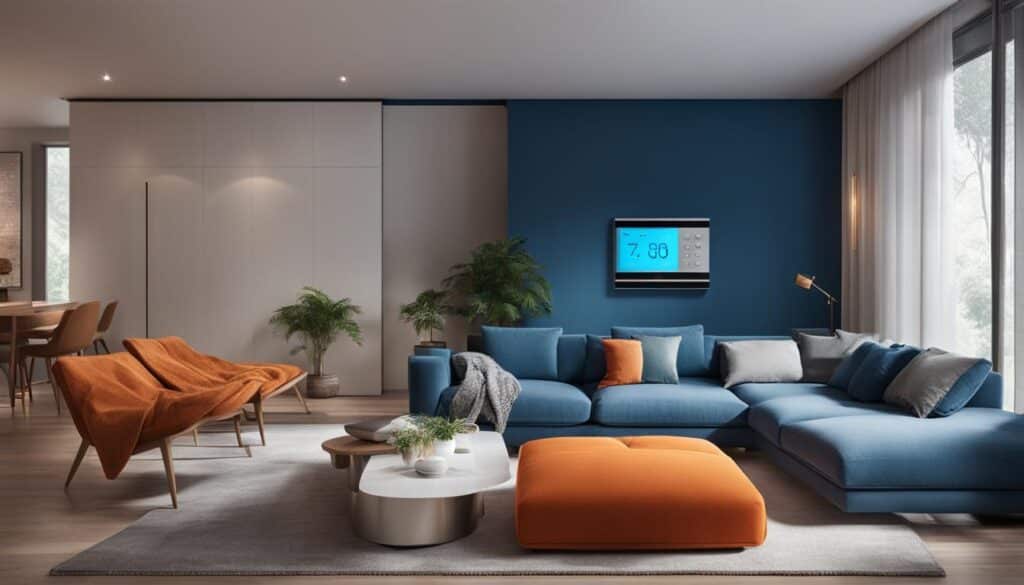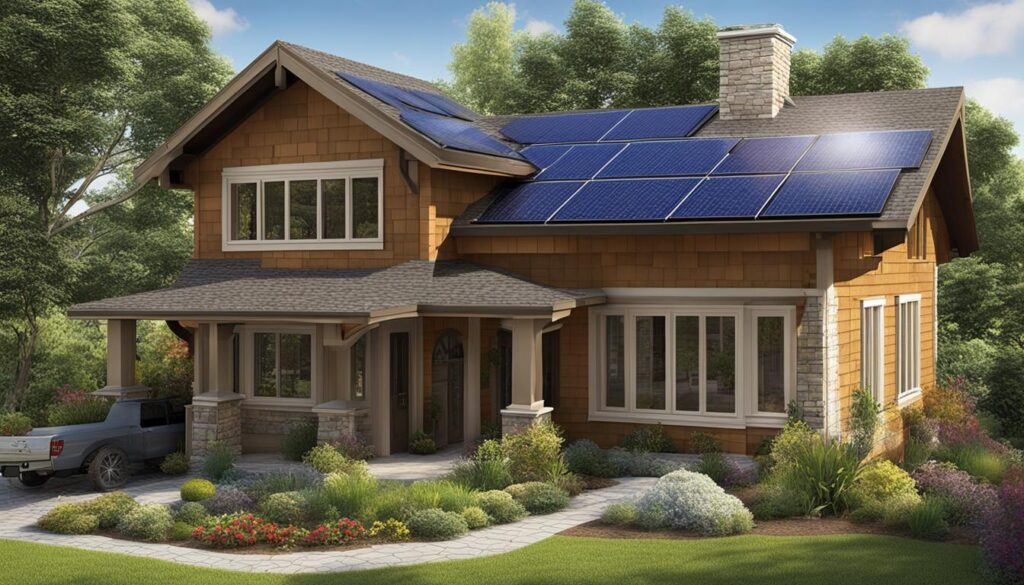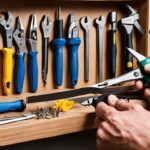I have always been passionate about finding cost-effective ways to boost home efficiency and save money and energy. As a homeowner myself, I understand the importance of finding inexpensive energy-saving home improvements that make a significant difference without breaking the bank.
Fortunately, there are several simple and affordable strategies that can help homeowners enhance the energy efficiency of their homes. By implementing these strategies, you can not only reduce your environmental impact but also enjoy long-term savings on your utility bills.
Table of Contents
Key Takeaways:
- Implementing cost-effective strategies can significantly boost home efficiency.
- Inexpensive energy-saving home improvements can lead to long-term savings on utility bills.
- Reducing your environmental impact is a win-win situation for both your wallet and the planet.
- Simple changes like insulation, energy-efficient lighting, and smart thermostats can make a big difference.
- By being mindful of energy consumption, we can contribute to a greener and more sustainable future.
Simple Tips for Insulating Your Home
Proper insulation is essential for maintaining a comfortable temperature in the home and reducing energy waste. By implementing a few simple strategies, homeowners can significantly improve the energy efficiency of their homes and lower their utility bills.
1. Install Energy-Efficient Windows and Doors
Upgrading to energy-efficient windows and doors can make a significant difference in your home’s insulation. These products are designed to minimize heat transfer, keeping your home warmer in the winter and cooler in the summer. Look for windows and doors with high energy-efficiency ratings, such as those certified by ENERGY STAR®. Not only will you save on energy costs, but you’ll also enhance the overall comfort of your home.
2. Weatherstripping
Weatherstripping is an effective way to seal gaps and cracks around windows and doors, preventing drafts and reducing heat loss. It involves applying adhesive strips or seals to the edges of windows, doors, and other areas where air can infiltrate. Weatherstripping is a cost-effective solution that can significantly improve insulation and enhance energy efficiency.
3. Caulking
Caulking is another simple and affordable way to improve home insulation. By sealing gaps, cracks, and joints around windows, doors, and other surfaces, you can prevent air leaks and improve the efficiency of your HVAC system. Choose a high-quality caulking material that is suitable for your specific application, ensuring a tight seal and long-lasting results.
4. Add Insulation Materials
Adding insulation to key areas of your home can provide significant energy savings. Start by insulating your attic, as this is where a significant amount of heat loss occurs. Consider using fiberglass or cellulose insulation, which are both effective and affordable options. Additionally, insulating exterior walls and floors can further improve energy efficiency and create a more comfortable living environment.
Remember to consult with a professional insulation contractor to determine the most suitable insulation materials and techniques for your specific home.
| Insulation Material | R-Value per inch | Cost per square foot |
|---|---|---|
| Fiberglass | 2.2 – 4.3 | $0.30 – $0.80 |
| Cellulose | 3.2 – 3.8 | $0.40 – $0.85 |
| Spray Foam | 3.6 – 8.0 | $1.00 – $3.00 |
| Mineral Wool | 3.0 – 4.2 | $0.70 – $1.20 |
Upgrading to Energy-Efficient Lighting
Lighting is a significant contributor to a home’s energy consumption. By making the switch to energy-efficient lighting options, homeowners can not only reduce their electricity usage but also save money on their energy bills. Two popular choices for energy-efficient lighting are LED bulbs and compact fluorescent bulbs.
LED bulbs are widely recognized for their exceptional energy efficiency and long lifespan. Compared to traditional incandescent bulbs, LED bulbs use significantly less energy, making them a sustainable choice for homeowners. Additionally, LED bulbs emit less heat, reducing the strain on air conditioning systems during the warmer months. The energy savings and extended lifespan of LED bulbs make them an ideal option for long-term cost savings and environmental impact.
Compact fluorescent bulbs (CFLs) are another energy-efficient lighting option that has gained popularity in recent years. CFLs use about 75% less energy than incandescent bulbs and typically last up to ten times longer. Although CFLs initially cost more than traditional incandescent bulbs, the long-term energy savings and extended lifespan make them a wise investment. Additionally, CFLs produce less heat, resulting in additional energy savings by reducing the need for air conditioning.
Smart Lighting for Enhanced Energy Efficiency
In addition to LED bulbs and CFLs, homeowners can further optimize their energy efficiency by installing smart lighting systems. Smart lighting systems offer advanced features and controls that allow users to customize lighting levels and usage according to their preferences and needs. This level of control helps to avoid unnecessary energy consumption by ensuring that lights are only used when and where they are needed.
Smart lighting systems often include features such as motion sensors, dimmers, and programmable schedules. Motion sensors automatically detect movement and turn lights on and off accordingly, ensuring that lights are not left on when a room is unoccupied. Dimmers provide the flexibility to adjust the brightness of the lights, helping to create the desired ambiance while conserving energy. Programmable schedules allow homeowners to set specific lighting patterns for different times of day, optimizing energy efficiency throughout the day.
Furthermore, smart lighting systems can be controlled remotely through smartphones or voice-controlled devices. This allows homeowners to turn lights on or off from anywhere, providing convenience while also reducing energy waste. Some systems even provide energy usage insights, allowing homeowners to monitor and track their lighting consumption, identify patterns, and make informed decisions on further energy-saving strategies.

By upgrading to energy-efficient lighting, homeowners can significantly reduce their energy consumption, lower their environmental impact, and save money on their energy bills. LED bulbs and compact fluorescent bulbs offer long-term energy savings and extended lifespans, while smart lighting systems provide advanced control and customization options for enhanced energy efficiency. Making these simple changes in lighting choices can have a significant impact on both the environment and your pocket.
Using Smart Thermostats for Heating and Cooling
Heating and cooling systems are among the biggest energy consumers in a home. To optimize energy efficiency and reduce costs, homeowners should consider installing programmable or smart thermostats.
Programmable thermostats allow individuals to set customized heating and cooling schedules that align with their daily routines. By programming specific temperature settings for different times of the day, homeowners can ensure that their HVAC systems operate efficiently, providing them with the ideal comfort without wasting energy when no one is at home.
Smart thermostats take energy-efficient temperature control to the next level. In addition to programmable features, they offer advanced functionalities such as remote control and energy usage tracking. With remote control capabilities, homeowners can adjust their thermostats even when they are away from home, ensuring comfort upon their return. Energy usage tracking provides valuable insights into energy consumption patterns, allowing homeowners to identify opportunities for further optimization.
By using programmable or smart thermostats, homeowners can significantly reduce their energy consumption and lower their utility bills. The ability to customize heating and cooling schedules and access energy usage data empowers individuals to make informed decisions that align with their energy-efficiency goals.
Benefits of Programmable and Smart Thermostats:
- Customized heating and cooling schedules
- Optimized energy efficiency
- Remote control capabilities
- Energy usage tracking and insights

“Using smart thermostats can result in significant energy savings while still keeping your home comfortable at all times.”
Conclusion
Incorporating inexpensive energy-saving home improvements into your living space can have a significant impact on both your wallet and the environment. By implementing cost-effective strategies such as proper insulation, energy-efficient lighting, and smart thermostats, you can enhance your home’s efficiency and reduce your carbon footprint.
With the rising costs of energy, it’s important to find ways to save money and energy without sacrificing comfort. Insulating your home can prevent heat loss and reduce the amount of energy needed to maintain a comfortable temperature. Energy-efficient lighting options like LED bulbs and compact fluorescent bulbs can significantly reduce electricity consumption while providing ample illumination. And by using programmable or smart thermostats, you can optimize temperature control and customize heating and cooling settings to match your lifestyle.
By taking these simple steps, you not only save money on your energy bills but also contribute to a greener and more sustainable future. Enhancing home efficiency is a win-win solution that benefits both homeowners and the planet. So why wait? Start implementing these inexpensive energy-saving home improvements and be part of the movement toward a more energy-efficient world.
FAQ
What are some inexpensive energy-saving home improvements?
Some cost-effective ways to boost home efficiency and save money and energy include proper insulation, upgrading to energy-efficient lighting, and using smart thermostats for heating and cooling.
How does home insulation help with energy savings?
Home insulation is essential for maintaining a comfortable temperature in the home and reducing energy waste. By insulating attics, walls, and floors, homeowners can prevent heat loss and improve energy efficiency.
What are some energy-efficient lighting options?
Switching to LED bulbs or compact fluorescent bulbs can significantly reduce electricity usage and save money on energy bills. Installing smart lighting systems also provides more control over lighting levels and usage.
How can smart thermostats help with energy savings?
Smart thermostats allow homeowners to set customized heating and cooling schedules, matching their daily routines. This results in more efficient temperature control and significant energy savings. Smart thermostats also offer features like remote control and energy usage tracking.


